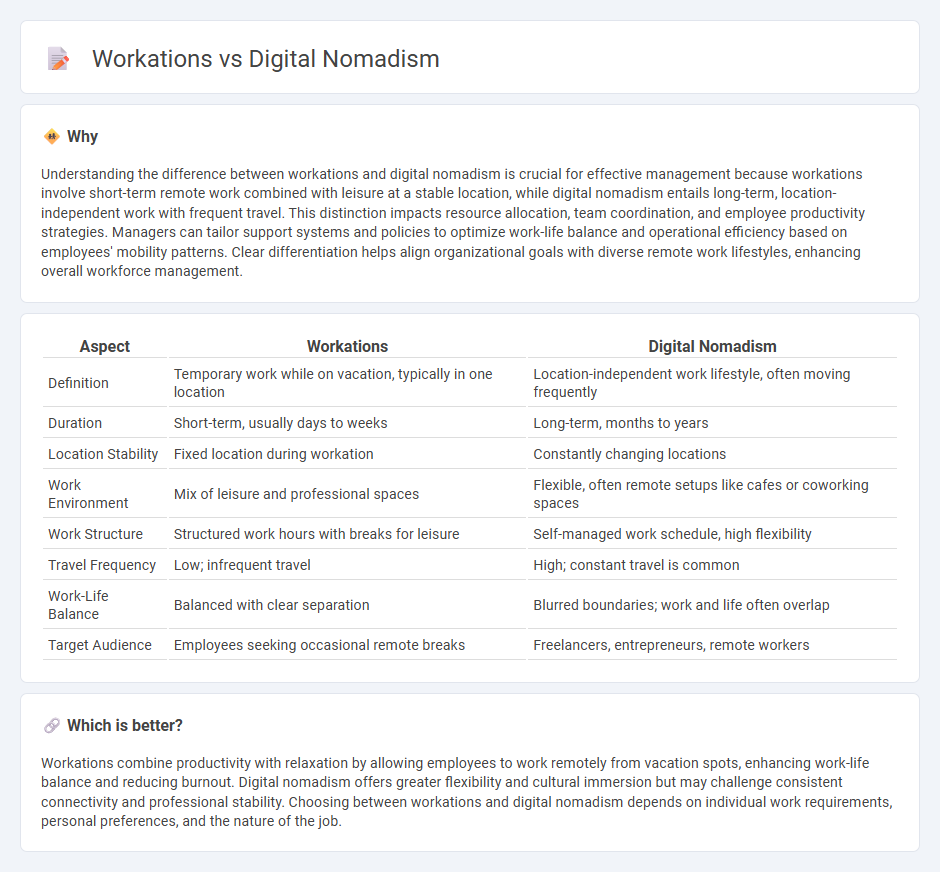
Workations combine work and leisure by allowing employees to temporarily work from vacation destinations, promoting relaxation alongside productivity. Digital nomadism involves individuals leveraging technology to work remotely while continuously traveling and exploring new locations. Discover how both trends are reshaping modern work-life balance and organizational strategies.
Why it is important
Understanding the difference between workations and digital nomadism is crucial for effective management because workations involve short-term remote work combined with leisure at a stable location, while digital nomadism entails long-term, location-independent work with frequent travel. This distinction impacts resource allocation, team coordination, and employee productivity strategies. Managers can tailor support systems and policies to optimize work-life balance and operational efficiency based on employees' mobility patterns. Clear differentiation helps align organizational goals with diverse remote work lifestyles, enhancing overall workforce management.
Comparison Table
| Aspect | Workations | Digital Nomadism |
|---|---|---|
| Definition | Temporary work while on vacation, typically in one location | Location-independent work lifestyle, often moving frequently |
| Duration | Short-term, usually days to weeks | Long-term, months to years |
| Location Stability | Fixed location during workation | Constantly changing locations |
| Work Environment | Mix of leisure and professional spaces | Flexible, often remote setups like cafes or coworking spaces |
| Work Structure | Structured work hours with breaks for leisure | Self-managed work schedule, high flexibility |
| Travel Frequency | Low; infrequent travel | High; constant travel is common |
| Work-Life Balance | Balanced with clear separation | Blurred boundaries; work and life often overlap |
| Target Audience | Employees seeking occasional remote breaks | Freelancers, entrepreneurs, remote workers |
Which is better?
Workations combine productivity with relaxation by allowing employees to work remotely from vacation spots, enhancing work-life balance and reducing burnout. Digital nomadism offers greater flexibility and cultural immersion but may challenge consistent connectivity and professional stability. Choosing between workations and digital nomadism depends on individual work requirements, personal preferences, and the nature of the job.
Connection
Workations and digital nomadism are interconnected by the growing trend of remote work, enabling professionals to combine travel with productivity. Both concepts emphasize flexibility, allowing employees to maintain work-life balance while exploring new environments. Companies adopt these models to boost employee satisfaction, creativity, and retention by supporting location-independent work.
Key Terms
Remote Work
Remote work enables professionals to embrace digital nomadism, allowing seamless travel while maintaining job responsibilities using cloud-based tools and virtual collaboration platforms. Workations combine work and vacation by staying temporarily in one destination, offering a balance between productivity and relaxation with local experiences. Explore more about how these flexible work styles enhance productivity and lifestyle integration in the evolving remote work landscape.
Work-Life Balance
Digital nomadism and workations both offer flexible work environments that enhance work-life balance by allowing professionals to blend productivity with leisure. Digital nomads typically embrace long-term remote work while traveling, optimizing time management and personal freedom, whereas workations emphasize short-term stays that combine professional tasks with relaxation to prevent burnout. Explore effective strategies to maintain work-life harmony in dynamic work settings by learning more about these evolving trends.
Location Independence
Digital nomadism emphasizes full location independence by allowing individuals to live and work remotely from any global destination without a fixed base. Workations combine work and vacation, often involving short-term stays at specific destinations, blending productivity with leisure but typically lacking long-term mobility. Explore the nuances and benefits of each lifestyle to determine which best supports your location-independent goals.
Source and External Links
Digital nomad - Wikipedia - A digital nomad is someone who works remotely while traveling, often relying on internet technology to maintain location independence, frequently seeking lower cost of living and diverse experiences in different regions.
The New Reality of Digital Nomads - Harvard Business Review - Digital nomadism has surged, with over 17 million Americans identifying as digital nomads, a trend accelerated by the rise of digital nomad visas and the expansion of remote work beyond tech professionals to include families and retirees.
2024 Digital Nomads Trends Report - MBO Partners - Nearly all digital nomads plan to continue the lifestyle, valuing freedom, flexibility, and the ability to engage in geo-arbitrage by earning in high-income countries while living in low-cost destinations.
 dowidth.com
dowidth.com